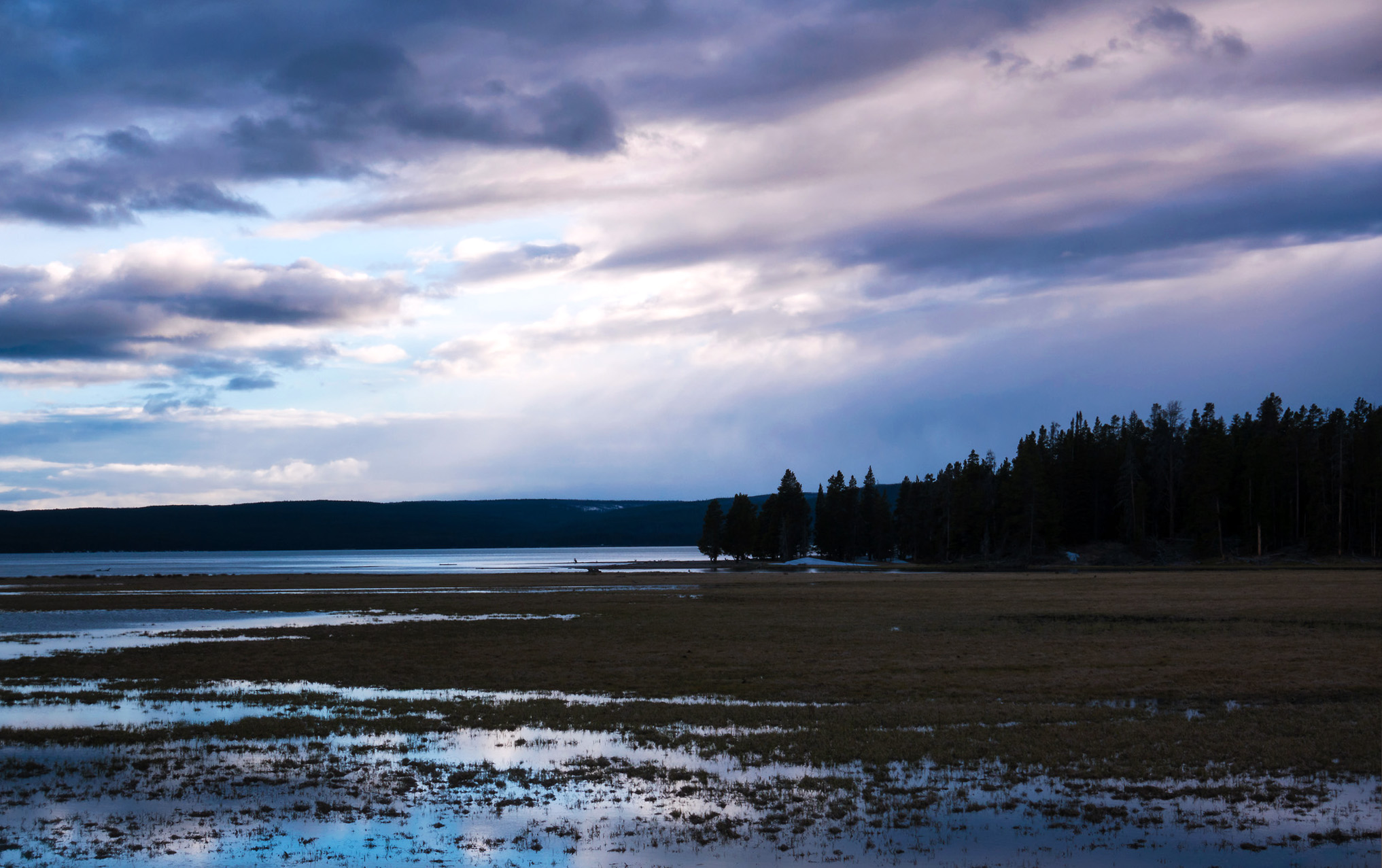Another day, another journey to the north. Jane calls the park road hotline in the early morning, and a pre-recorded message tells us that the road break at Canyon is still a day away from being fully repaired. So it's back in the car, back over the Continental Divide, and back on another long ride through the geyser basins, this time bound for the town of Mammoth at the northwestern corner of the park. Jane flips through our satellite radio to kill time, settling on a standup comedy station that keeps us entertained for the rest of the ride ("Guns don't kill people, people kill people! Toasters don't toast toast, people toast toast!"). As we descend the hill from Madison Junction into the river valley, we are momentarily stalled by our first (but not last) herd of bison traffic. Carefully, I ease the rental car around and past the great beasts, eager to not startle any of them. In the early hours of the morning, we reach Gibson Falls and crest the pass to see steam rising from the Norris Geyser Basin below. Our first stop of the day is roadside at Roaring Mountain, an eerie, barren peak rendered uninhabitable by its phalanx of fumaroles and hissing steam vents. Even among the grotesqueries of the Yellowstone Caldera, this living, fiery mountain is a particularly unnerving piece of landscape.
There is long traffic stop caused by road repairs as we enter Obsidian Canyon, but when we finally get underway again, what follows is a liberating descent from the mountain pass into Swan Lake Flat, a gorgeous expanse of tawny grassland dotted with glacial kettles and rolling drumlins, with the snow-capped Gallatin Range rising imperially to the northwest, and the Washburn Range cutting across the winding meadows to our southeast. At the north end of the flats, we leave the car at the foot of Bunsen Peak, a hulking mountain that guards the pass into Mammoth. With our daypacks and winter gear in tow, we set off up the mountain trail.
The trail climbs gradually through regenerating lodgepole forest before emerging onto a steep hillside with views overlooking the Golden Gate Canyon, the descent toward town, and the northern reaches of the Gallatin Range beyond (above). We follow the hillside up and onto a tall snowbank which persists along all the enclosed and north-facing nooks and hollows along the trail. It is slow and icy going without crampons (not to mention dangerous, with steep drop-offs to the side of some ice caps), but we manage to inch our way forward with the help of old footsteps left deep in the snow. Past the first set of snowbanks, the trail swings across an open alpine meadow with easy walking through dirt and sage. We make our way up the switchbacks; Jane picks up a pine cone while I pause to enjoy the view over the flats (below). As we ascend, the northward view to the valley below continues to widen. We pass through fire-scarred blowdown and across talus slopes, and finally back into pine forest, with its attendant shade and layers of snowbanks stretching as far as we can see up the slope. Stymied by the flat rubber soles on our old worn walking boots, we stop a few hundred feet short of the summit to rest and enjoy the view before making the descent back to the car. We're used to this now: it wouldn't be our spring vacation if we didn't take on a mountain trail too early in the season.
On our way down the mountain, we spot, far below us, a massive parade of bison coming south through the mountain pass to reach their summer pasture. Some hug the winding canyon walls as best they can, while others walk brazenly down the asphalt as if they built and paid for Park Loop Road; regardless, ungulate traffic has the right of way in Yellowstone, and we in our line of red brake lights can only sit back and admire. Back in the car, we join the procession heading northward into Mammoth, stopping briefly at roadside to photograph the lovely fan of Rustic Falls, where Glen Creek drops precipitously on its way from the flanks of the Gallatin Range to join the Gardiner River in the east. A pair or ravens hops around the parking turnoff, scrounging for crumbs from tourists; we watch as they fly to their hungry nestlings in an alcove on the opposite canyon wall.
Mammoth is a bustling little settlement nestled at the foot of its world-famous travertine terraces and hot springs. This mountain of shapely silver and pink mineral deposits, sitting there on the hillside like the long-forgotten grand prize trophy of some divine sculpting contest, is visible from every part of town. At first a ramshackle dump of inns and saloons, Mammoth became a U.S. army outpost in the late 1800s when the War Department, sick of watching Yellowstone be run into the ground by a hapless civilian administration, deployed a company of cavalry to take control of the fledgling national park from poachers and profiteers. The military administration, with its regimented approach to chain of command, backcountry patrols, and tight regulations on wildlife and natural resource management, set the foundations for what was to eventually become the modern National Park Service, whose park headquarters remain located at Mammoth.
We stop first at the Mammoth Terrace Grill, where I order a cheeseburger and Jane orders a bowl of bison chili with rice ("Hot food!" we rejoice). After lunch, we walk to the boardwalks and stroll around the travertine terraces. These limestone deposits are a wonder to behold, built over millennia by the action of hot springs supersaturated with minerals, then rounded and sculpted by flowing water, and finally streaked in shades of pastel by thermophilic bacteria. They stand in lovely contrast to the lush green valley of the Gardiner River, and the eroded tongues of sandstone on the flank of Mt. Everts to our east.
After walking around the terraces, we take a brief detour to see Wraith Falls to the east before we resume our route home. Jane, ever wanting to see little spattering puddles of mud, talks me into stopping at the Artist Paint Pots, where we power-walk through nearly a mile of forest and climb a 200-foot hillside to arrive at what I can only describe as the most disappointing little spattering mud puddles I have ever personally seen. Our tremendous gasping for breath, the bewildered disappointment of the other sightseers on hand, and the sardonic little "plops" of the vomit-beige mud bubbles - in combination, these things send Jane into fits of laughter. We power-walk back to the car past families with strollers, grandparents with walkers, and one very sizeable woman who is struggling to make it past the parking lot bench - wanting very badly to tell them to turn around while they still can. The rest of our 1.5-hour drive back to the lake is uneventful.
In the late afternoon, we get dressed and walk from our cabin to the Lake Hotel, where we have an early dinner reservation that I made when we booked everything else for the honeymoon (in true cruise ship/Disneyland fashion, the dining room tables book out early, and it can be a real struggle for the hungry tourist to find non-sandwich food here in the shoulder season if he or she doesn't plan early). With its pastel yellow paint job and quaint colonial architecture, the hotel is quite charming. We sit in the reading room for some time while our table is prepared, looking out onto the veranda and the azure blue water of Yellowstone Lake beyond. Wisps of cumulus float through the mountains in the east, and a light drizzle begins to fall, dappling the glass surface of the lake. After perusing our dinner menu with its cheeky Papyrus font, we start with a set of lamb sliders with goat cheese. I order a bison tenderloin with mashed potatoes, while Jane has grilled quail on a bed of rice. The food is tasty but mostly forgettable, and we are both glad we didn't make any additional reservations for our stay.
After our meal, I hang around outside while Jane relaxes in the cabin. With the clouds drifting in, the chances of a brilliant panoramic sunset are slim, so we choose to stay close by for the golden hour. We drive a few minutes to the east along the north shore of the lake, stopping to watch a family of ducks on Indian Pond before settling at the outlet of Pelican Creek, just up the road from the trailhead to Storm Point. The marsh where the creek empties into the lake is shrouded lavender purple as the sun falls to the west. The wetlands are still but not quiet; we are kept company by a choir of croaking frogs, with the intermittent splish-splash of trout breaking the surface. Jane watches for awhile with the binoculars, mostly spotting ducks and the occasional heron, before we head home for the night.















